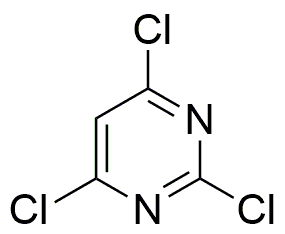2,4,6-Trichloropyrimidine is widely utilized in research focused on:
- Agricultural Chemicals: This compound serves as a key intermediate in the synthesis of herbicides, offering effective weed control in crops while minimizing environmental impact.
- Pharmaceutical Development: It is used in the creation of various pharmaceuticals, particularly in developing antiviral and anticancer agents, enhancing therapeutic options for patients.
- Material Science: The compound is incorporated in the production of specialty polymers and coatings, providing improved durability and resistance to harsh conditions.
- Analytical Chemistry: It acts as a reagent in analytical methods, aiding in the detection and quantification of other compounds, which is crucial for quality control in various industries.
- Research Applications: Utilized in laboratory settings for synthesizing other complex organic compounds, facilitating advancements in chemical research and development.
General Information
Properties
Safety and Regulations
Applications
2,4,6-Trichloropyrimidine is widely utilized in research focused on:
- Agricultural Chemicals: This compound serves as a key intermediate in the synthesis of herbicides, offering effective weed control in crops while minimizing environmental impact.
- Pharmaceutical Development: It is used in the creation of various pharmaceuticals, particularly in developing antiviral and anticancer agents, enhancing therapeutic options for patients.
- Material Science: The compound is incorporated in the production of specialty polymers and coatings, providing improved durability and resistance to harsh conditions.
- Analytical Chemistry: It acts as a reagent in analytical methods, aiding in the detection and quantification of other compounds, which is crucial for quality control in various industries.
- Research Applications: Utilized in laboratory settings for synthesizing other complex organic compounds, facilitating advancements in chemical research and development.
Documents
Safety Data Sheets (SDS)
The SDS provides comprehensive safety information on handling, storage, and disposal of the product.
Product Specification (PS)
The PS provides a comprehensive breakdown of the product’s properties, including chemical composition, physical state, purity, and storage requirements. It also details acceptable quality ranges and the product's intended applications.
Certificates of Analysis (COA)
Search for Certificates of Analysis (COA) by entering the products Lot Number. Lot and Batch Numbers can be found on a product’s label following the words ‘Lot’ or ‘Batch’.
*Catalog Number
*Lot Number
Certificates Of Origin (COO)
This COO confirms the country where the product was manufactured, and also details the materials and components used in it and whether it is derived from natural, synthetic, or other specific sources. This certificate may be required for customs, trade, and regulatory compliance.
*Catalog Number
*Lot Number
Safety Data Sheets (SDS)
The SDS provides comprehensive safety information on handling, storage, and disposal of the product.
DownloadProduct Specification (PS)
The PS provides a comprehensive breakdown of the product’s properties, including chemical composition, physical state, purity, and storage requirements. It also details acceptable quality ranges and the product's intended applications.
DownloadCertificates of Analysis (COA)
Search for Certificates of Analysis (COA) by entering the products Lot Number. Lot and Batch Numbers can be found on a product’s label following the words ‘Lot’ or ‘Batch’.
*Catalog Number
*Lot Number
Certificates Of Origin (COO)
This COO confirms the country where the product was manufactured, and also details the materials and components used in it and whether it is derived from natural, synthetic, or other specific sources. This certificate may be required for customs, trade, and regulatory compliance.


